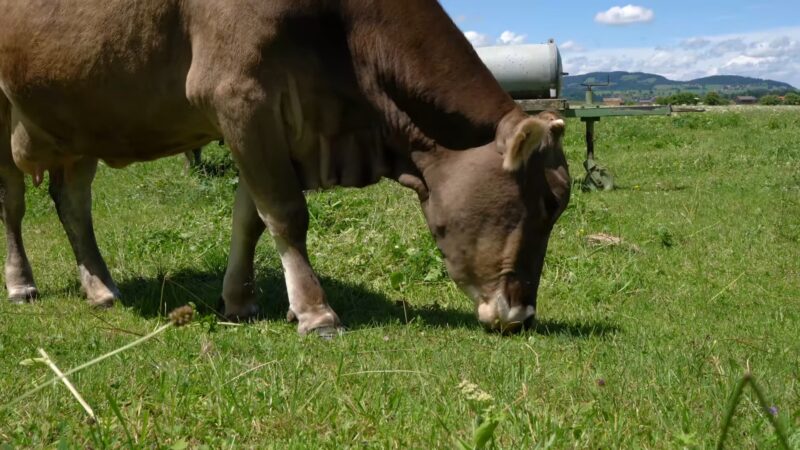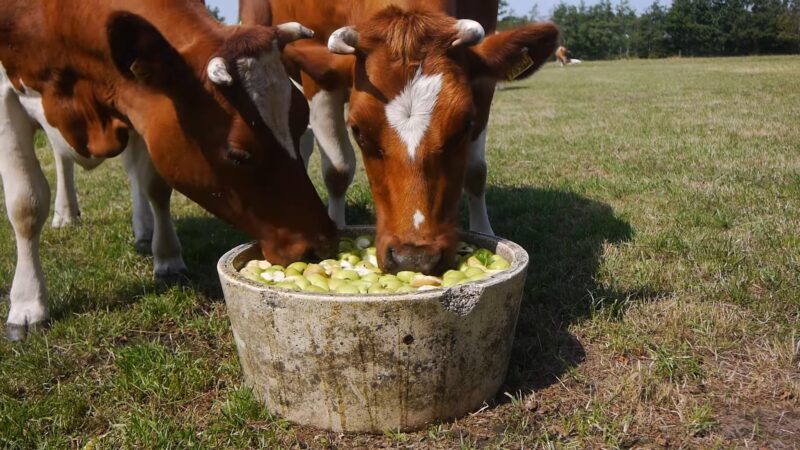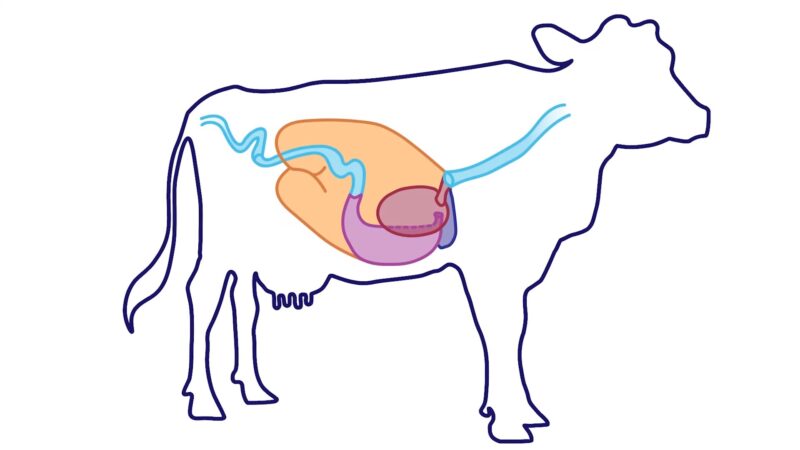Hello, dear readers! As a seasoned veterinarian, I’ve had the privilege of working with a wide variety of animals, each with its unique quirks and characteristics.
Today, I’m excited to delve into a topic that has piqued the curiosity of many, including fans of the famous cartoon, Cow and Chicken. Yes, we’re going to answer the question: How many stomachs does a cow have?
While Cow and Chicken provided plenty of laughs, it didn’t exactly offer a realistic depiction of bovine biology. So, let’s leave the cartoon world behind for a moment and dive into the fascinating reality of a cow’s digestive system.
We’ll explore the intricacies of a cow’s stomach, or should I say stomachs? We’ll delve into the reasons behind this unique physiological feature, its role in digestion, and the evolutionary advantages it provides.
Ruminant Digestive System
Ruminants, including cows, sheep, goats, deer, and even moose, are a distinct group of mammals that have developed a sophisticated and effective digestive system to extract nutrients from plant-based foods.
The term “ruminant” is derived from the Latin word “ruminare,” which translates to “to chew over again.” This is a direct reference to the process of regurgitation and re-chewing of food, a behavior that is characteristic of these animals and is commonly referred to as “cud-chewing.”
The ruminant digestive system is a marvel of evolution, designed to thrive in environments where the available food is high in fibrous plant material but low in nutritional content. This system allows ruminants to extract the maximum possible nutrition from these foods, providing them with the energy they need to survive and thrive.
The Four-Part Stomach
When we ask, “How many stomachs does a cow have?” the answer is technically one, but this single stomach is divided into four distinct compartments: the rumen, the reticulum, the omasum, and the abomasum. Each of these compartments plays a unique role in the digestion process, and the food a cow consumes will pass through each one in sequence.
The Rumen
The rumen acts as a fermentation chamber in which food, along with saliva and rumen fluid, are combined to start the process of breaking down intricate plant substances. Within the rumen, an abundance of microorganisms like bacteria, fungi, and protozoa can be found.
In a research article from 2020, the rumen protozoa were classified as entodinomorphs and holotrichs, and they play a significant role in the decomposition of fibrous plant materials. These microorganisms work together to ferment and break down the fibrous plant matter into simpler compounds, which the cow can then utilize for energy.
The Reticulum
The reticulum is the second compartment and works in tandem with the rumen. It acts as a sort of ‘filter’, trapping larger food particles that require further breakdown and sending them back to the rumen for additional fermentation.
The Omasum
The third compartment, the omasum, functions like a sieve. It absorbs water and other substances from the food and further breaks down the food particles into even smaller pieces.
The Abomasum
The abomasum is the final compartment and is most similar to a human stomach. Here, the food is treated with enzymes and acid to break it down further. The digested food is then passed into the small intestine, where nutrients are absorbed.
The Journey of Digestion

The process of digestion in a cow is a fascinating journey that begins the moment it takes its first bite of food. Cows, being grazing animals, spend a significant part of their day eating. They have a large capacity for food but chew very little before swallowing.
The food first enters the rumen, where it is stored and begins to be broken down by the microorganisms present. After a period of fermentation in the rumen, the food (now referred to as cud) is regurgitated back into the cow’s mouth, where it is chewed again to further break it down.
This re-chewed cud is then swallowed again and passes through the reticulum and omasum, where further digestion and absorption of water occur. Finally, the cud reaches the abomasum, where it is treated with enzymes and acid to break it down into a form that can be absorbed in the intestines.
An Evolutionary Journey
The evolution of the ruminant digestive system is a testament to the adaptability of animals to their environment. Cows and other ruminants have evolved this complex system to survive in environments where the available food is high in fibrous plant material but low in nutritional content.
The multiple compartments of a cow’s stomach allow it to extract the maximum possible nutrition from these foods. The process of fermentation in the rumen, in particular, allows it to break down complex plant materials that many other animals cannot digest.
Benefits of a Multi-Compartment Stomach

The multi-compartment stomach of a cow offers several advantages. First, it allows the cow to consume large amounts of food quickly and then digest it over a longer period. This is particularly useful in environments where it needs to eat as much as possible when food is available.
Second, the process of fermentation in the rumen allows the cow to break down complex plant materials and extract nutrients that many other animals cannot access. This includes cellulose, a major component of plant cell walls, which is indigestible to many animals.
Finally, the microorganisms in the rumen also produce vitamins and other nutrients that the cow can absorb and use. This includes vitamin B12, which is essential for the cow’s health and is not found in plant materials.
Ruminant Digestive System and Humans
The ruminant digestive system is not only important for cows and other ruminants, but it also has significant implications for humans. All ruminants are able to convert plant materials into milk and meat, which are important sources of nutrition for many people.
In addition, the manure produced by cows is a valuable source of fertilizer, which can be used to improve soil fertility and crop production. The methane gas produced by the fermentation process in the rumen can also be captured and used as a source of renewable energy.
FAQ
What is ruminal acidosis?
Ruminal acidosis is a digestive disorder that occurs when the pH of the rumen becomes too acidic. This is usually caused by consuming too much grain or other high-starch feed and not enough forage. It can lead to decreased milk production, loss of appetite, and other health problems in cows.
What is the environmental impact of the ruminant digestive system?
While the ruminant digestive system allows these animals to convert plant materials into valuable food products, it also produces methane, a potent greenhouse gas. Strategies to reduce methane emissions from ruminants are an active area of research.
How does diet affect the digestive system?
A balanced diet is crucial for maintaining an optimal rumen pH level. A diet too rich in easily fermentable carbohydrates can lead to a rapid drop in rumen pH, causing a condition known as ruminal acidosis, which can severely affect the health of the animal.
What is the role of microorganisms in a cow’s stomach?
Microorganisms, including bacteria, protozoa, and fungi, play a crucial role in the rumen, the first compartment of a cow’s stomach. They help ferment and break down the fibrous plant material into simpler compounds that it can use for energy.
How long does food stay in a cow’s stomach?
The process of digestion in a cow can take 24 to 72 hours on average. The rate can vary depending on the type of food and the individual cow’s metabolism.
Can cows digest cellulose?
Yes, cows can digest cellulose, a major component of plant cell walls, thanks to the microorganisms in their rumen. These microorganisms break down cellulose into simpler compounds that they can use for energy.
What is the role of the cow’s saliva in digestion?
Saliva in cows plays a crucial role in digestion. It contains enzymes that start the digestion process, and it helps to lubricate the food for easier swallowing. Saliva also helps to regulate the pH in the rumen, providing an optimal environment for the microorganisms that aid in digestion.
Final Words
As we conclude our journey into the fascinating world of bovine biology, I hope you’ve found the answer to “How many stomachs does a cow have?” as intriguing as I have. The ruminant digestive system is a marvel of evolution, allowing cows to extract maximum nutrition from their environment.
Moreover, this unique system has significant implications for us humans, providing us with nutritious food, valuable fertilizer, and even a potential source of renewable energy. As a seasoned veterinarian, I’ve enjoyed sharing this insight into the world of cows with you.
Whether you’re a curious reader, an aspiring vet, or a farmer, I hope you’ve found this exploration as fascinating as I have. Until next time, stay curious!
Related Posts:
- How Does the Greenlash Impact the Casino Industry in…
- Are Turtles Reptiles? Fascinating Reptiles Explained
- How Do Whales Breastfeed Underwater? - Marine Mammal…
- Why Do Moose Have Antlers? - From Decoration to Weaponry
- Do Sharks Have Tongues? (Revealing the Hidden Depths)
- Do Bears Have Tails? - Find Out the Truth Here








